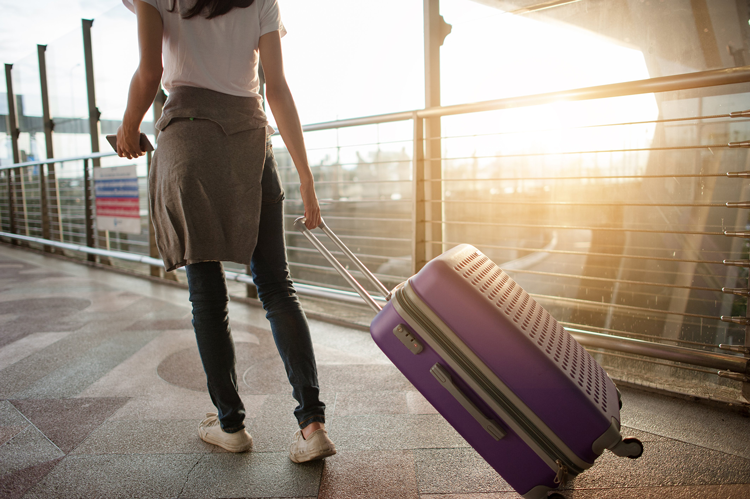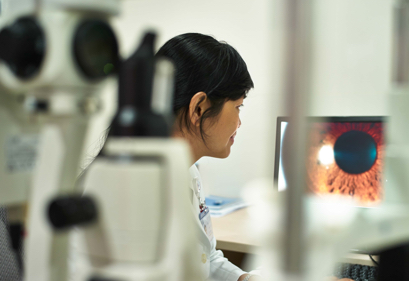When you’re traveling for business or pleasure, it’s easy to slip out of your normal routine. Maybe you skip your daily workouts. Or perhaps you overindulge in food and fun.
You might even fail to follow your regular regimen for wearing and caring for your contact lenses.
Unfortunately, slacking off when it comes to your contacts could result in hassles, discomfort or, worse yet, an eye infection.
Here are nine tips for being prepared and being equipped to travel with contact lenses:
1. Pay attention to your eyewear prescriptions
At least a few weeks before you pack your business suit or your bathing suit, get your eyes checked to make sure your contact lens and eyeglass prescriptions are up to date.
This is especially important if you’re going to be away from home for an extended period and if you’re heading to another country.
Aside from bringing a backup pair of glasses with you, stick copies of your prescriptions for contacts and glasses in an accessible bag in case of an emergency.
The numbers that appear on your prescriptions are recognized around the world, meaning you can order new contacts or glasses in Texas or Taiwan.
2. Pack all of your eye care gear
In addition to contact lens solution and a backup pair of glasses, don’t forget to take along at least a couple of leak-proof contact cases as well as spare contacts and any other eye care supplies you need, the University of Alabama at Birmingham School of Optometry suggests.
You might not wind up using all of them, but it’s best to be on the safe side
3. Know the travel security rules

A smart move when you’re flying: Pack a travel-size container of contact lens solution in your carry-on and pack a larger container of contact lens solution in your checked bag.
However you divide it up, make sure you’ve got enough contact lens solution to last the entirety of your trip.
No matter whether you’re flying to Boston or Budapest, Transportation Security Administration (TSA) regulations could affect you as a wearer of contact lenses.
TSA allows contact lenses in both carry-on bags and checked bags. Contact lens solution is another story, however.
A container of contact lens solution that you stick in your carry-on bag must contain 3.4 ounces of liquid or less, and all of your carry-on liquids must fit into a clear quart-size plastic bag.
The size of liquids in your checked bag isn’t restricted.
4. Consider switching to disposable contact lenses
If you’ll be visiting a place with less-than-ideal hygiene conditions, consider changing to daily disposable contact lenses if you don’t wear them already, the University of Michigan’s Student Life University Health Service recommends.
With disposable contact lenses, you can toss your lenses each night without having to clean or store them.
5. Practice good contact lens hygiene
No matter where you are traveling, be sure to wash your hands thoroughly with soap and water before touching your contact lenses or your eyes, the University of Michigan advises.
Your hands should be dry before touching a lens or an eye.
In addition, remove and clean your lenses every day, and wash your lens cases with storage solution.
Furthermore, wear your contacts only for the recommended period and resist the urge to leave your contact lenses in overnight, the University of Alabama at Birmingham says.
Also, never use water for contact lens storage, the U.S. Centers for Disease Control and Prevention (CDC) suggests.
6. Don’t wear contacts in the water

Your risk of fungal, bacterial or amoeba-borne eye infections goes up when you wear contacts while swimming.
Regardless of whether you’re splashing around in the ocean or doing laps at the hotel swimming pool, remove your contacts before entering the water.
Courtesy of the University of Alabama at Birmingham, here are three pointers for wearers of contact lenses who do decide to keep them in while swimming:
• Wear daily disposable contacts, if possible, and toss them once you’re done swimming.
• Put on goggles before going into the water.
• Throw soft contacts away after getting out of the water, even if they’re not daily disposable contacts.
7. Shield yourself from the sun
Aside from applying sunscreen to your skin, you should take precautions to protect your eyes from exposure to dangerous UV rays. One way to protect yourself: Consider getting contact lenses with UV protection .
These precautions include wearing polarized sunglasses, putting on a large-brimmed hat and possibly wearing UV-blocking contacts, according to the University of Alabama at Birmingham.
8. Don’t take chances with your sight
If one or both of your eyes become red, painful, blurry or sensitive to light, remove your contact lenses right away, the University of Alabama at Birmingham says. After that:
• Put contact lenses in their case rather than throw them away. Doctors might want to take cultures from the contacts or the case to figure out what’s bothering your eyes.
• Wear eyeglasses until you can get your eyes checked by an eye doctor.
• Obey your eye doctor’s orders about your contacts. For instance, if a doctor tells you to stop wearing contacts for a week to give your eyes time to heal, follow the advice.
9. Don’t buy questionable contacts on your travels
Particularly in another country, you might spot contact lenses for sale at a corner store. Simply put, don’t buy them.
Never purchase contacts unless they’ve been prescribed for you, the CDC says. Wearing contacts that haven’t been prescribed can harm your vision.
Source. Allaboutvision






